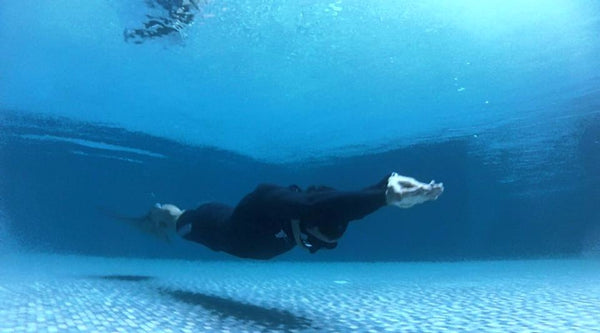Molchanovs Monofin Review (by Adrian and Cong)

User Experience by Adrian
I recently received my new Molochanovs sport monofin – the S2. Moving from bi-fins to a monofin is a big step as a monofin requires a totally different finning technique and relies on different muscles and movement to generate thrust.
One of the things I found challenging was the fact that it is more difficult to correct your body position and “trim” your swim (especially when swimming slowly) with both feet attached together – this is something we do naturally with bi-fins. Also, playing with the number of cycle across the pool and the cycle pattern has been important – for example whether you kick, kick, kick across the pool, or kick, kick, glide, etc. Then there is also the question of amplitude and how big a kick movement you are making and how much effort you put into the down motion and up motion.
Thinking about all these variables was a bit daunting. So, I took the monofin workshop with Michelle. It was a huge help and I recommend it to any aspiring monofinners, because getting some basics on technique, the proper muscle groups to use, how to dry train and some experience dolphin kicking with short fins is all very helpful for when you try the unwieldy mono.
In the beginning, I felt that I wasn’t really more efficient that with bi-fins, which is strange because we are supposed to be on the order of >20% more efficient with a mono fin. I expected to see that in either speed or number of kick cycles. When counting cycles with bi-fins and comparing it with the number of cycles with a monfin (and doubling it because one is using both feet together) didn’t really seem to be that much more efficient. Over time, I have improved and do see a difference now. I watched videos of Alexi and how many cycles he uses and the pattern he follows, which was reassuring. I also have noticed that my contractions seem to start later with a monofin compared to bi-fins. So, it seems that the monofin does deliver quite a bit in terms of efficiency.
I’m still very much a beginner here and look forward to improving my technique, distance and O2 consumption over time. If you ever want to give it a try, let me know, I’m happy to share.
Technical Review by Cong
The newer model of the Molchanovs sport monofin improved with a soft tip that runs along the flat edge of the blade. This gives the monofin considerably more stability during finning and a more intimate feel of the water, although the amount of force that can be transferred to the water is somewhat reduced. Overall, this is a significant improvement for its use in freediving.
The older and newer models we tested were both of the same stiffness (2/5). With the older model, any uneven kick from the diver makes the monofin react with a little wobble - viewed from behind, you would see that the monofin moves downwards through the water at a tilted angle, instead of being horizontal. This sensation of instability can be distracting, with the diver often resulting to making small movements to correct for the misalignment in the water. However, this wobble was barely detectable with the soft-tip monofin, even when deliberately trying to kick unevenly – the monofin’s soft tip avoids forcing the blade through the water at an awkward angle. Accordingly, kicking with the newer model is considerably more comfortable, giving a better feel for the water, and allowing the mind to better disengage and relax.
Being softer, there is less power that can be generated from every kick. While this effect is noticeable, we do not think that the impact is particularly large; in our experience, it took about one extra kick per fifty meters. Far more important was the sheer comfort and stability afforded, which helped push back the start of contractions by a considerable margin, and made for a more rewarding dive.
